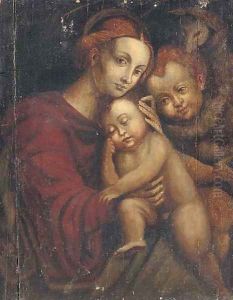Bernadino Luini Paintings
Bernardino Luini was an Italian painter from the Lombardy region, who was active during the High Renaissance. He was born around 1480 in Dumenza, a small town near Lake Maggiore, though some sources suggest he could have been born directly in Milan. Luini's death is placed around 1532 in Milan. His artistic career is often associated with the Lombard school, and his works exhibit a strong influence from Leonardo da Vinci, who was the dominant figure in Milanese painting during Luini's formative years.
Luini's early life and training are not well documented, but it is believed that he was a pupil of Stefano Scotto, a lesser-known Milanese painter. Luini's style, however, developed significantly beyond Scotto's influence, as he began to incorporate the sfumato technique and the tender expressiveness characteristic of Leonardo's work. Luini's paintings are known for their clarity of form, delicate coloring, and graceful compositions. His frescoes and altar pieces often featured religious themes, executed with a gentle narrative style that made them quite popular during his lifetime.
Among his notable works are the frescoes in the Monastero Maggiore in Milan and the Santa Maria degli Angeli church in Lugano, which showcase his mastery of large-scale compositions and his ability to create a harmonious blend of architecture and painted decoration. Additionally, Luini's panel paintings, such as 'Salome with the Head of John the Baptist' and 'The Virgin and Child with Saints', demonstrate his skill in smaller, more intimate formats.
Luini's influence extended to his contemporaries and the generation of artists that followed, with his approach to painting being a significant contribution to the Lombard tradition. While not as famous as Leonardo, Luini's work was rediscovered and appreciated in the centuries after his death, and today, he is recognized as one of the important contributors to the High Renaissance in Northern Italy.
